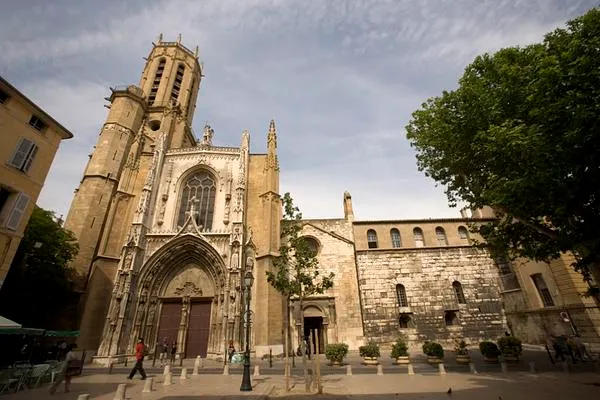Introduction
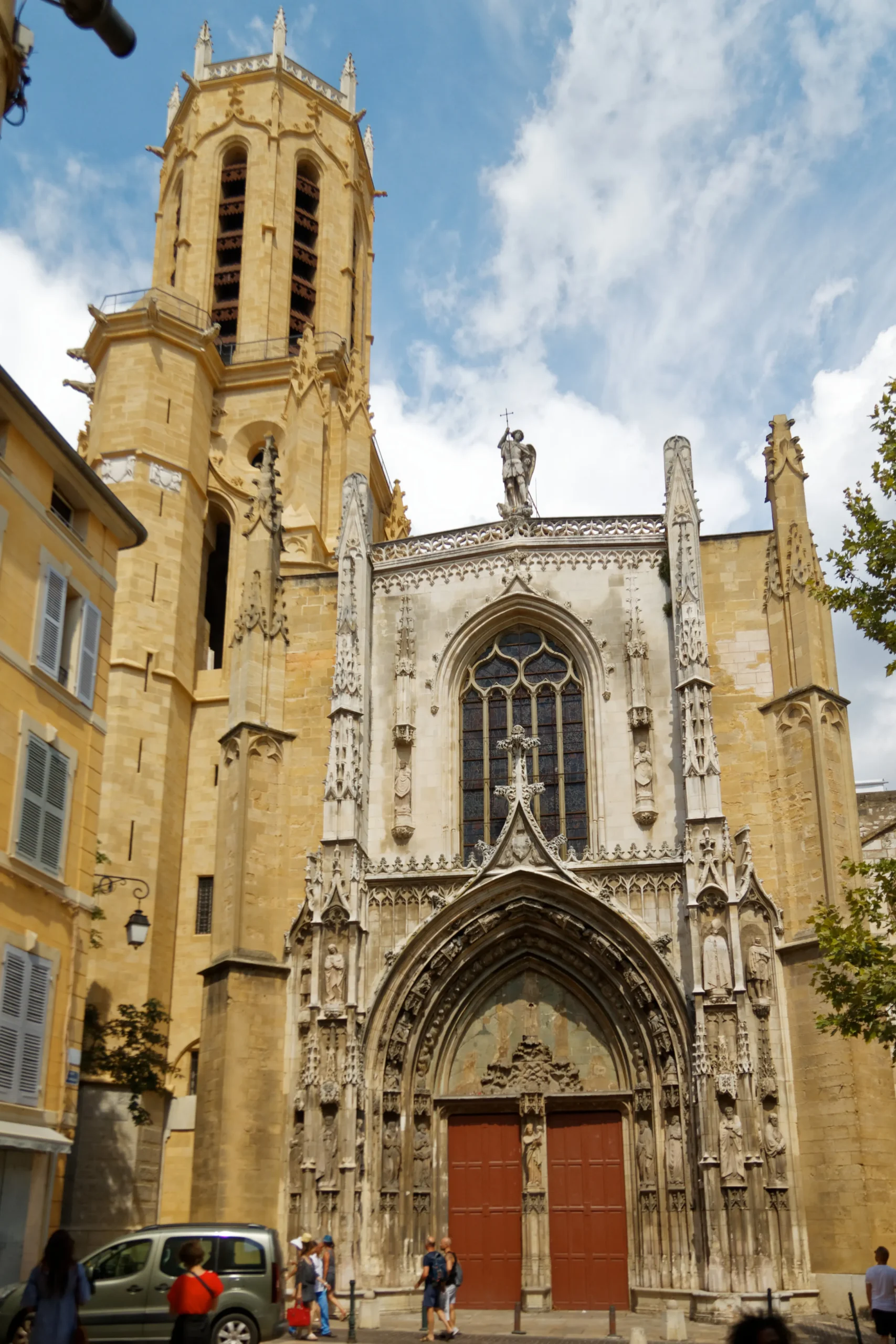
Aix Cathedral (French: Cathédrale Saint-Sauveur d’Aix-en-Provence) is a Roman Catholic church located in Aix-en-Provence, southern France. It serves as the seat of the Archbishop of Aix-en-Provence and Arles. The cathedral is built on the site of a 1st-century Roman forum, and according to legend, atop the foundations of an ancient temple dedicated to the god Apollo. Construction of the cathedral spanned several centuries, from the 12th to the 19th century, incorporating Romanesque, Gothic, and Neo-Gothic elements, as well as Roman columns and portions of the baptistery from a 6th-century Christian church. It is classified as a national monument of France.
The Cathedral, located at Rue Gaston-de-Saporta 2, measures 70 meters in length, 46 meters in width, and stands 20 meters below the keystone. The façade reveals three distinct stages of construction: the original Romanesque nave built in the 12th century, followed by a wall of antique blocks with bossages, constructed with live joints on beds of tow. The most recent addition is the 16th-century portal that closes the Gothic nave. Over the centuries, several buildings were added around the cathedral, including the cloister of the canons (late 12th century), other cloister structures (11th to 13th centuries), and the bell tower, which was completed in 1425. Aix Cathedral is the cathedral church of the Archdiocese of Aix-en-Provence.
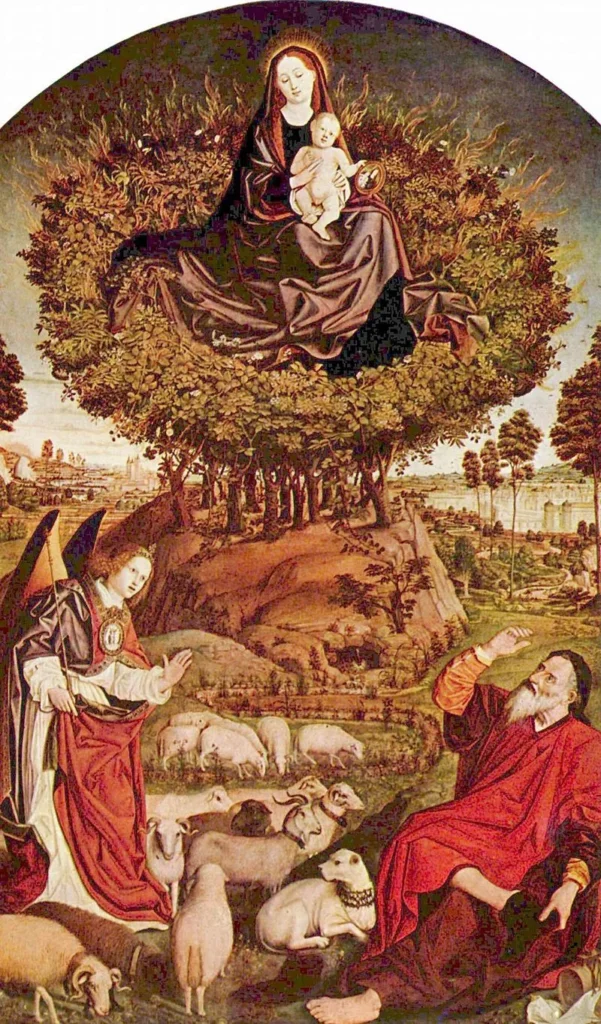
Origin of the Cathedral
The cathedral is located on the route of the Roman road, the Via Aurelia. A fragment of a Roman wall and the columns of the baptistery seem to be the origin of the legend that the church was built on top of a Roman temple dedicated to Apollo. The historian Scholastique Pitton (1668) claimed that the temple had been dedicated to a sun god, basing his claim upon the discovery of the leg of a statue uncovered at the site.
According to the Christian tradition, the first church on the site was founded by Saint Maximinus of Aix, who arrived in Provence from Bethany, a village near Jerusalem, with Mary Magdalene on a boat belonging to Lazarus. Maximin built a modest chapel on the site of the present cathedral and dedicated it to the Holy Saviour (le Saint Sauveur). During the invasion of the Saracens in the 8th and 9th centuries, the original chapel of Saint-Sauveur was destroyed.
Construction of the Cathedral
Around 500 AD, under Bishop Basilius, a series of episcopal buildings was constructed over the old Roman forum. This complex included a chapel, a baptistery, and various other rooms. In the early 12th century, a new church was built on this site, featuring Romanesque walls and three bays forming a wide, single nave. This parish church was dedicated to the Virgin Mary (Notre Dame de la Sède). Around 1165–1177, a second nave dedicated to Saint Maximinus was added as the canons’ church, positioned between the original nave and the baptistery. The choir of this second nave concluded with a flat wall, connected by a door to the Sainte-Chapelle, which was part of the original 6th-century episcopal buildings. This chapel was rebuilt in the 12th century and later integrated into the cathedral as the Oratory of the Saviour. It remained until its destruction in 1808.
By the late 12th and early 13th centuries, Aix had become the capital of Provence, leading to rapid growth in population and significance. Religious orders, including the Franciscans, Dominicans, Carmelites, and Augustinians, arrived and established churches, monasteries, and convents. The expansion of the cathedral mirrored Aix’s growing importance. Two new Gothic transept wings were started around 1285–1290 and completed in 1316. Gradually, the old Romanesque church was transformed into a Gothic cathedral, bay by bay.
Construction halted during the Black Death and the Hundred Years’ War, resuming only in 1472 with the building of the final bay. The façade took another thirty years to complete, and the last statues were installed in 1513, marking the cathedral’s transition into the Renaissance era.
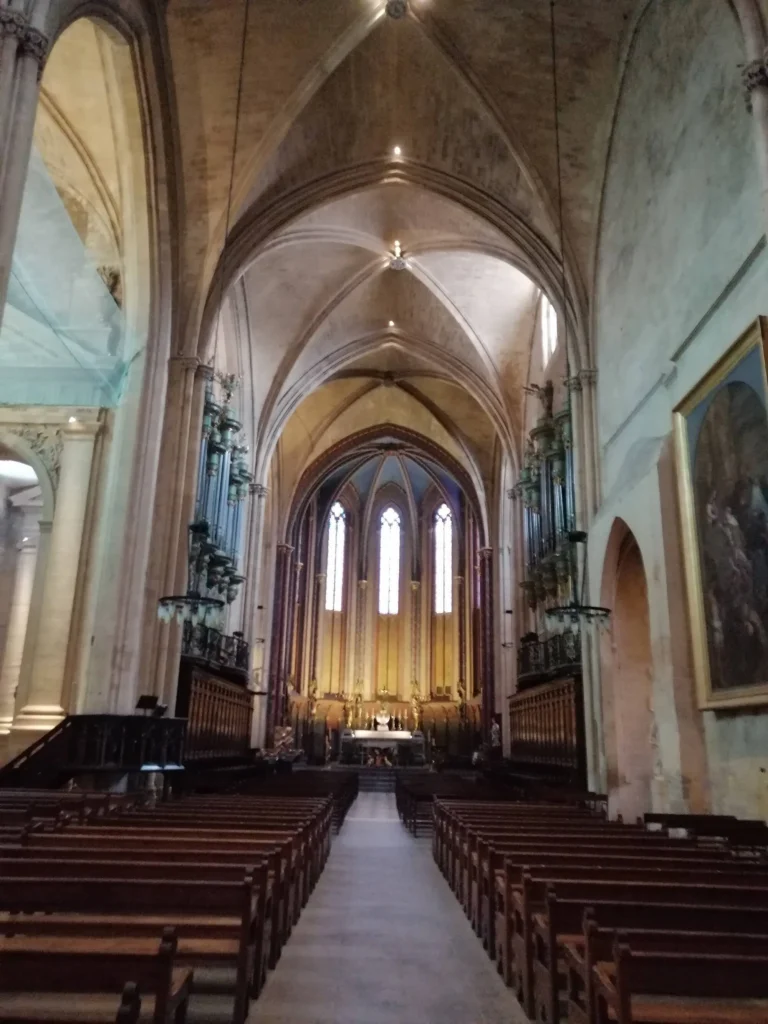
Architectural Style: Gothic Architecture, Romanesque Architecture
The Baptistery of Aix Cathedral appears to date back to the 6th century, while the construction of the Romanesque part of the cathedral began at the end of the 11th century under Archbishop Rostang de Fos and the provost of the chapter, Benoît. The southern nave, known as Corpus Domini, is dedicated with an inscription from 1103. However, one wall of the cathedral appears older, likely dating from the High Middle Ages. On December 11, 1471, Archbishop Georges-Olivier de Pannard, with the approval of the chapter, decided to construct the final span to the west. A contract was signed with Hélion l’Auvergnat, a stonecutter from Arles, on April 16, 1472. On May 13, 1472, the archbishop and the chapter reached an agreement on the financing of this project. In 1477, Hélion l’Auvergnat began work on the façade, but by the time of de Pannard’s death in 1484, only the base of the statues had been completed.
A document from April 7, 1484, indicates that Jacotin Paparoche was carving statues of the apostles, while Pierre Souquet took over the architectural and ornamental work based on the plans of his predecessor. He signed an agreement with the chapter on July 3, 1484, but did not begin the task in earnest until around 1489. Discussions between Archbishop Philippe Herbert and the chapter led to a halt in the work until 1499. Pierre Souquet signed a new contract on November 20, 1500, and directed the project until his death around October 10, 1505. On October 6, 1505, the glass painter Jean Joye signed a contract to execute the stained glass windows for the facade. On February 20, 1507, Jean Lagrime and Pierre Guief were commissioned to create the sculpture of Saint Michael at the top of the facade. The sculptural work on the facade was completed in 1513, thanks to a donation from Louis Rostan. The sculptures were created by Jean Mone of Metz and were painted by Pierre Boeuf of Sisteron and Jean Cordonnier of Troyes.
Position of the Architectural Elements of the Building
Baroque: The northern aisle is characterized by Baroque architecture, added in the 17th century. This is one of the most recent additions to Aix Cathedral.
Gothic: The dominant architectural style of the cathedral is Gothic, which was introduced in the 16th century and remains the predominant style.
Roman: The Roman element is represented by eight antique columns and the baptistery, dating back to the 5th and 6th centuries. These are some of the earliest features of the cathedral.
Romanesque: The south side aisle is built in the Romanesque style, which was prevalent in the 11th and 12th centuries. It is fitting that this style is included in such an impressive structure.
Façade and Bell Tower
The Original Romanesque front of Saint Mary’s nave was destroyed in the 15th century, and replaced with a new Gothic front and a bell tower. The façade features four statues by Jean Mone, made in 1512–1513, on the middle level: Saint Mitre (carrying his head); Saint Mary Magdalene, (carrying a flask of perfume); the boy-bishop Saint Louis of Toulouse (d. 1297), the brother of Robert of Naples, Count of Provence 1309–1343; and the other Saint Louis, King Louis IX of France (d. 1270), his great-uncle.
Jacotin Paproche, from Picardy, sculpted the ten small prophets and twenty cherubim (1484) on the façade. Pierre Souquet created the two statues on the upper level, representing the first two bishops of Aix, traditionally named as Maximinus and Sidonius. The centrepiece of the façade is Saint Michael Crushing the Dragon (1507), by Jean Paumier, from Burgundy. The façade originally also included twelve statues of the apostles and six statues on the tympanum, which were destroyed during the French Revolution.
Carved doors
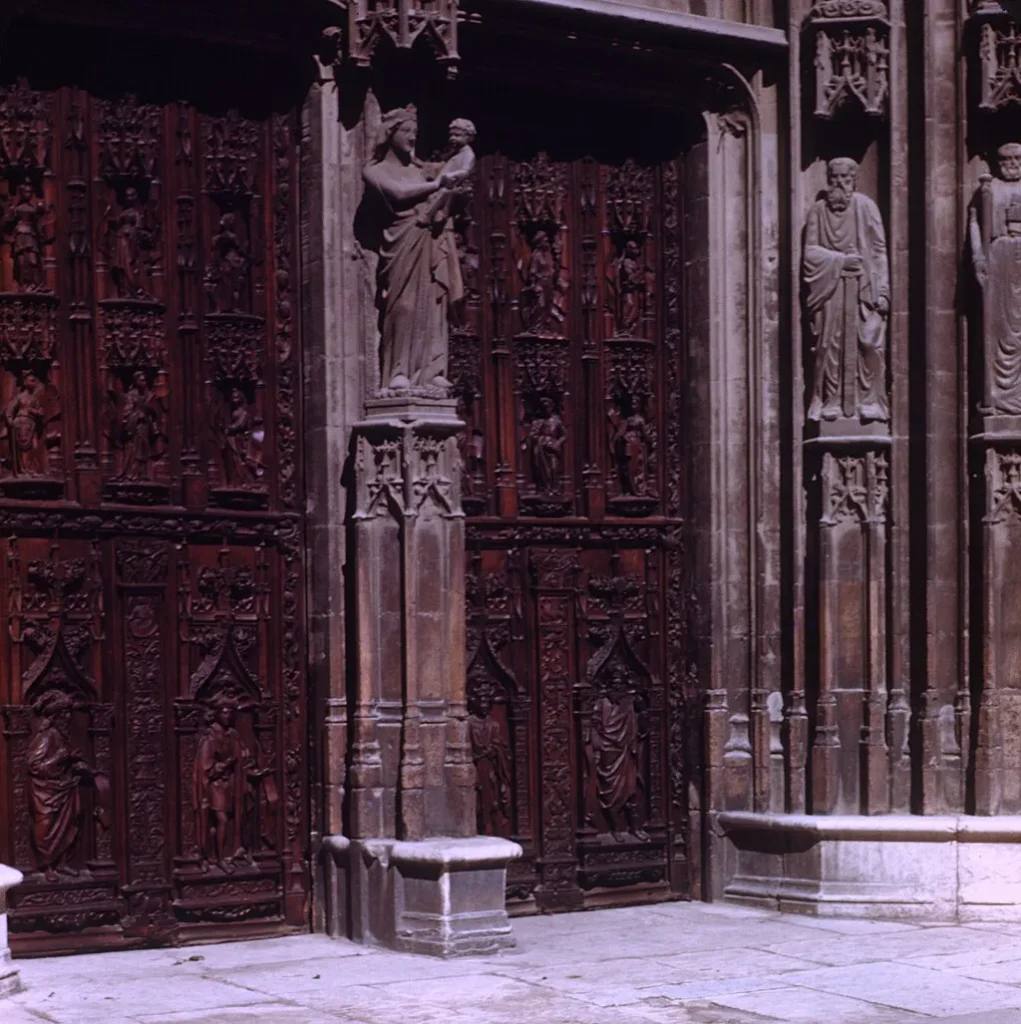
The Doors of the cathedral were commissioned by the chapter in 1505, and were carved of walnut by the brothers Raymond and Jean Bolhit of Aix and by the Toulon sculptor Jean Guiramand. The doors feature four figures in high relief of the major prophets of the Old Testament (Isaiah, Ezekiel, Daniel and Jeremiah). Above the prophets are the figures of twelve Sybils, pagan fortune-tellers from antiquity, honored by medieval Christian scholars for having predicted the birth, death and resurrection of Christ.The figures are framed with garlands of pomegranates and acorns, bunches of grapes, symbols of the Eucharist, a lion, a dragon and other fantastic animals: an asp (another type of dragon) and a basilisk, a cock with the tail of a snake, representing the battle between good and evil.
Baptistery
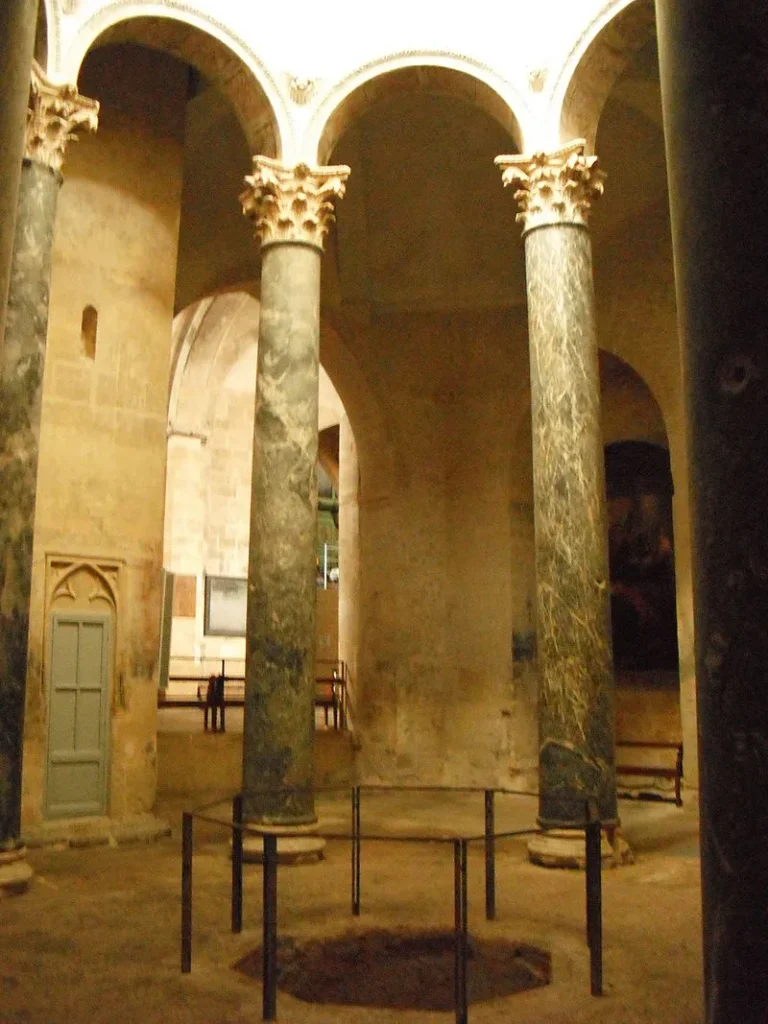
The Baptistery was built at the beginning of the 6th century, at about the same time as similar baptisteries in Fréjus Cathedral and Riez Cathedral in Provence, in Albenga in Liguria, and in Djémila, Algeria. Only the octagonal baptismal pool and the lower part of the walls remain from that period. The other walls and the dome were rebuilt in the Renaissance. A viewing hole in the floor reveals the bases of the porticoes of the Roman forum under the baptistery.
Cloister
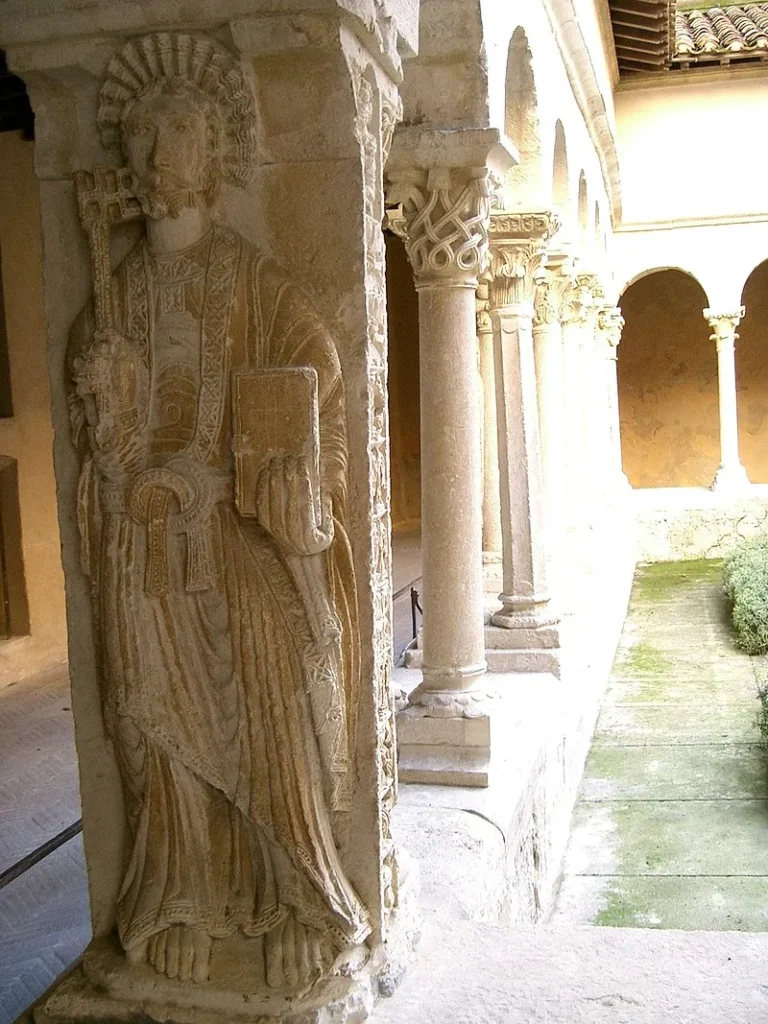
The Cloister was used by the canons, the priests who served the bishop and administered the church’s property. It was built at the end of the 12th century, at a time when canons were urged to live a more austere and more monastic communal life. The cloister was built upon the old Roman square, dating from the 1st century AD. The galleries were timbered and not vaulted, so the pairs of columns in the arcades that support them are slender and graceful.
The four columns at the angles of the cloister are decorated with carvings of the symbols of the four evangelists: an angel for St. Matthew; a lion for St. Mark; a bull for St. Luke; and an eagle for St. John.The capitals of the columns on the west and north are decorated with scenes from the New Testament and Old Testament, and with a statue of St. Peter. A marble slab in the west gallery, whose inscription has worn away, may be the tomb of Basilius, bishop of Aix in 500, and the builder of the first cathedral.
Organ
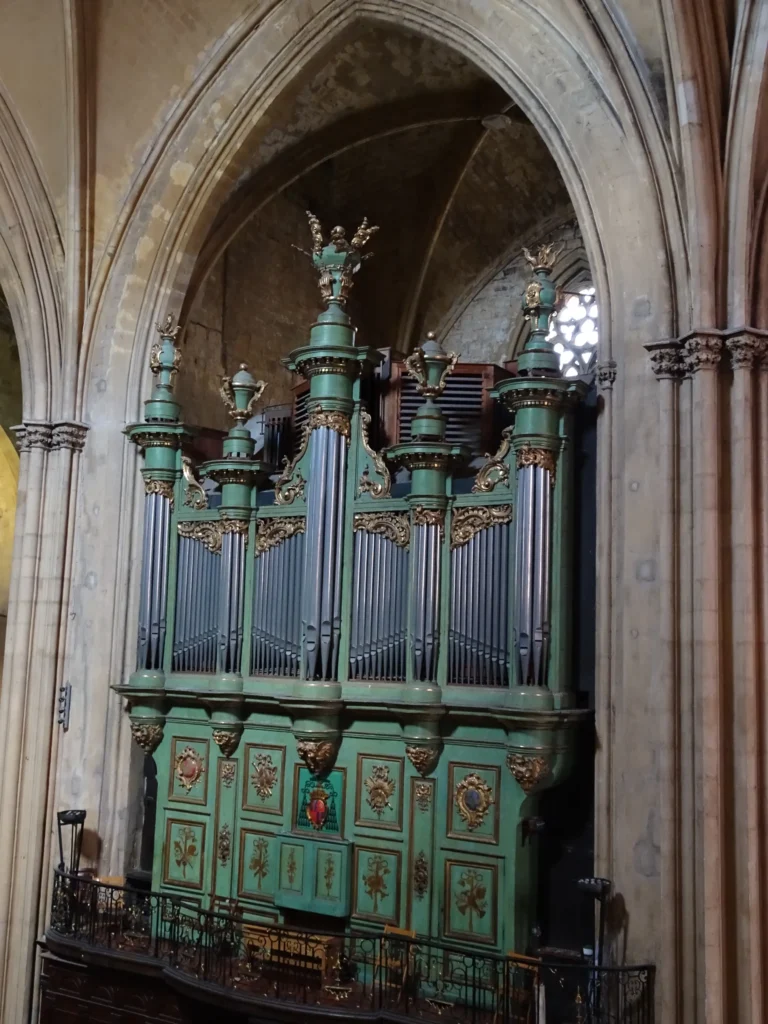
Around 1513, a small organ was installed sideways on a tribune above the stalls in the canonical choir. It was crafted by Brother Pierre Perrini, with a chest made by Jean Guiramand and shutters painted by Jean de Troyes. In 1612, a larger organ by builder Pierre Marchand was placed opposite the smaller one. This organ was later replaced in 1750 by the present “green and gold organ,” constructed between 1743 and 1746 by Brother Jean-Esprit Isnard, a Dominican from the Tarascon convent who built other significant organs in Provence, including the one at the basilica of Saint-Maximin. To create symmetry, an identical but non-functional organ chest was added where the small organ had been. In 1855, a new organ was installed within the original chest and was subsequently refurbished in 1867 and again in 1983.
Neo-Gothic decoration
Between 1857 and 1862, painted and sculpted neo-Gothic decoration was added to the nave. This work was led by Revoil, the diocesan architect, who collaborated with Viollet-le-Duc and his team during their restoration of the Sainte Chapelle in Paris, which was underway around the same period. Additional 19th-century embellishments included a high altar adorned with two gilded wooden angels crafted in the Empire style (1805).
Chapel of Saints Cosmas and Damian
This Chapel, built at the end of the 16th century and which constitutes the narthex of the baptistery, today houses a lapidary deposit, the most remarkable piece of which is the sarcophagus known as Saint Mitre , which is said to have received the remains of the Aix saint after his death as a martyr. Other elements also appear there, such as two marble lions from the tomb of Hubert de Vins, sculptures by Charles Desbordes , or even small columns with marble capitals from the Saint-Sauveur oratory.
The Bells
The Octagonal bell tower of the cathedral has three bells:
Bell 1: It is called “Marie Immaculée”, cast by Burdin in 1858 and it is 150 cm in diameter. It sings C3.
Bell 2: It is called “Paule”, cast by Paccard in 1932 and it is 150 cm in diameter. It sings the E3 .
Bell 3: It is called “Marie-Madeleine”, cast by Paccard in 1932 and it is 100 cm in diameter. It sings G3 .
Works of art in the cathedral
The Cathedral’s most notable artwork is the Burning Bush Triptych by Nicolas Froment. Other significant works include:
- Christ on the Cross with the Virgin of Sorrows, Saint Peter, and Saint Anthony (1640) by Jean Daret (the elder), located in the Chapel of the Sacred Heart;
- The Last Supper (1668) by Jean Daret (the younger), found in the south section of the transept;
- The Incredulity of St. Thomas (1613), painted by Flemish artist Louis Finson, displayed in the lower part of the Gothic nave;
- A series of seventeen tapestries depicting the life of Christ, purchased by the chapter in 1656 with funds from Archbishop Michel Mazarin’s legacy. Originally part of a set of twenty-six woven in 1511 for Canterbury Cathedral in England, these tapestries adorned Canterbury’s choir until 1642, when they were removed during the English Civil War. They eventually found their way to Paris, where the chapter acquired them for the cathedral’s choir. During the French Revolution, the tapestries were stolen but were later repurchased by the Archbishop of Aix-en-Provence and Arles. In 1977, nine of these tapestries were again stolen and have not been recovered.
Altar of the Aygosi family
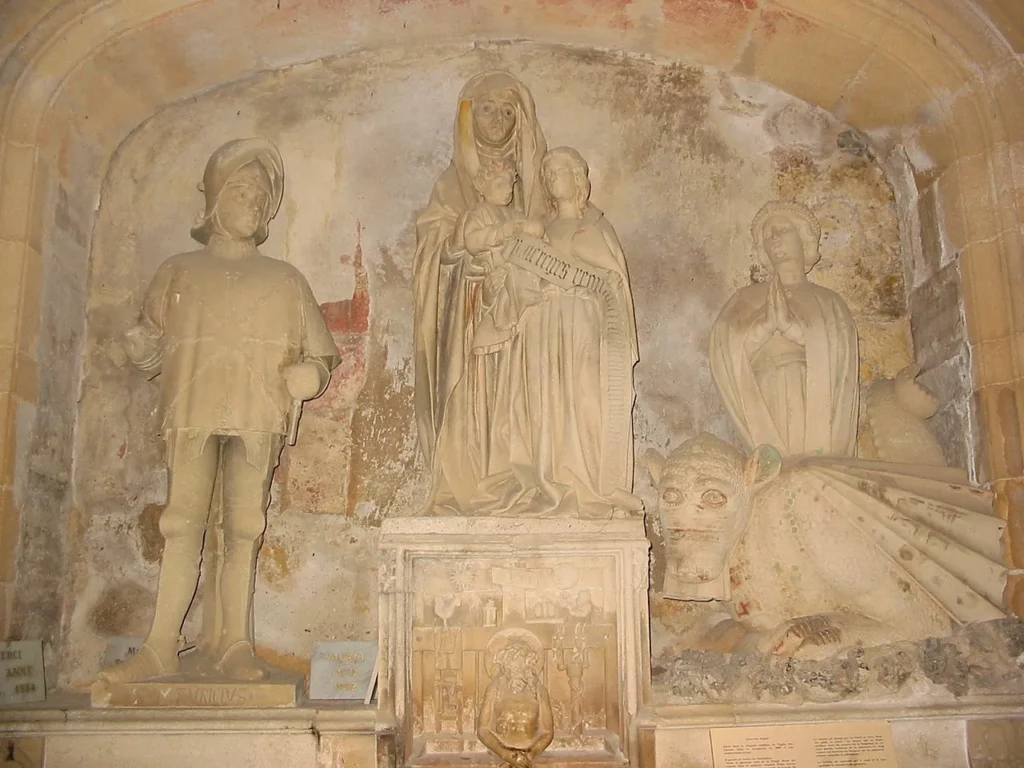
This Stone Altar, originally installed in the Church of the Carmelites in Aix, was moved to the cathedral in 1823. An inscription on the left side reads: “Anne, the glorious mother of the Virgin Mary, is venerated in this chapel. The nobleman Urbain Aygosi displays here the height of devotion. In the year of Our Lord 1470, this chapel was completed, by the grace of God, on January 28.”
The monument includes:
- An altar crowned by a false tabernacle, bearing the coat of arms of Urbain Aygosi (or Aygosy) on its edge;
- A tabernacle adorned with a figure of Christ and the inscription: “Look, mortal, it is for you that such a victim is offered”;
- A stone altarpiece with six figures: Saint Anne with the Virgin Mary holding the infant Jesus; Saint Maurice in 15th-century armor; Saint Margaret of Antioch accompanied by a dragon; and Christ on the Cross. Statues of the Virgin and Saint John, originally part of this altar, are now displayed at the Musée Granet.
The altar was sculpted by Audinet Stéphani, a native of Cambrai who worked in Aix and the surrounding region between 1446 and 1476.
Feast Day
Feast day: Le Festival des Arts de Saint-Sauveur: July 24–August 4, 2024
The Festival des Arts de Saint-Sauveur will take place from July 24 to August 4, 2024. This annual festival is held in Aix-en-Provence and celebrates various forms of artistic expression, including music, dance, and theater, with performances in different venues throughout the city. It is a key cultural event in the region, attracting both local and international artists and visitors.
Church Mass Timing
Monday : 8:00 a.m.
Tuesday : 8:00 a.m.
Wednesday : 8:00 a.m.
Thursday : 8:00 a.m.
Friday : 8:00 a.m.
Saturday : 8:00 a.m., 6:30 p.m.
Sunday : 10:30 a.m., 7:00 p.m.
Church Opening Time:
Monday : 8:00 am – 7:00 pm
Tuesday : 8:00 am – 7:00 pm
Wednesday : 8:00 am – 7:00 pm
Thursday : 8:00 am – 7:00 pm
Friday : 8:00 am – 7:00 pm
Saturday : 8:00 am – 7:00 pm
Sunday : 8:00 am – 7:00 pm
Contact Info
Address :
34 Pl. des Martyrs de la Resistance, 13100 Aix-en-Provence, France
Phone : +33442234565
Accommodations
Connectivities
Airway
The Nearest Airport to The Church of Paroisse Cathédrale Saint Sauveur Aix-en-Provence, France, is, Aérodrome Aix – Les Milles, Chem. de la Badesse, 13290 Aix-en-Provence, France, which is just 17 min (8.5 km) via N2516 away from the basilica.
Railway
The Nearest Railway to The Church of Paroisse Cathédrale Saint Sauveur Aix-en-Provence, France, is, Gare SNCF d’Aix-en-Provence Rue Gustave Desplaces, Aix-en-Provence, France, which is 8 min (2.0 km) via Rue de la Molle away from the basilica.

